» posted on Tuesday, July 2nd, 2024 by Linda Lou Burton
#18. Grant, Ulysses S
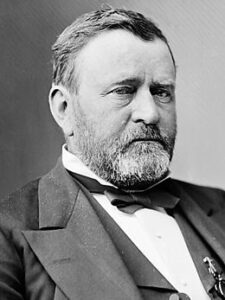 Linda Lou Burton posting from Little Rock, Arkansas – Ulysses S Grant (born Hiram Ulysses Grant; April 27, 1822 – July 23, 1885) was the 18th president of the United States, from 1869 to 1877. I won’t pull a Groucho Marx on you by asking “Who is buried in Grant’s Tomb?” but I wonder if you know WHY the tomb of Ulysses and Julia Grant is in New York City – Riverside Drive and W 122nd in Manhattan, to be exact. After all, he was born in Ohio and she was born in Missouri. Part of the answer is simply that’s where they were living when Ulysses died in 1885 and she wanted to easily be able to visit his grave. His only request was that his wife could be buried by his side, which left out military cemeteries (they didn’t accept women). But the clincher was this – within hours of Ulysses’ death, the Mayor offered New York as a burial place. Not long after the funeral, fundraising for a splendid monument began; the “military” design, based on Napoleon’s tomb, was completed in 1897, and Julia was buried beside her husband upon her death in 1902. The monument has been under the management of the National Park Service since 1958.
Linda Lou Burton posting from Little Rock, Arkansas – Ulysses S Grant (born Hiram Ulysses Grant; April 27, 1822 – July 23, 1885) was the 18th president of the United States, from 1869 to 1877. I won’t pull a Groucho Marx on you by asking “Who is buried in Grant’s Tomb?” but I wonder if you know WHY the tomb of Ulysses and Julia Grant is in New York City – Riverside Drive and W 122nd in Manhattan, to be exact. After all, he was born in Ohio and she was born in Missouri. Part of the answer is simply that’s where they were living when Ulysses died in 1885 and she wanted to easily be able to visit his grave. His only request was that his wife could be buried by his side, which left out military cemeteries (they didn’t accept women). But the clincher was this – within hours of Ulysses’ death, the Mayor offered New York as a burial place. Not long after the funeral, fundraising for a splendid monument began; the “military” design, based on Napoleon’s tomb, was completed in 1897, and Julia was buried beside her husband upon her death in 1902. The monument has been under the management of the National Park Service since 1958.
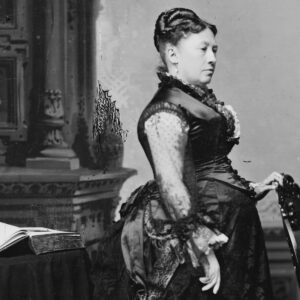 You might want to visit the site, because everything about the lives of Ulysses and Julia Grant is somewhat – unusual. Like the fact that Ulysses was a little guy, not the gigantor war hero I’d always envisioned. He was 5’2” when he arrived at West Point, although he did keep growing; the record books say he achieved 5’8” and about 150 pounds by the time he was president. And do you know why images of Julia are generally a profile view? She was cross-eyed. She was afraid of surgery in her younger days; when she became First Lady, she decided she should look better, but Ulysses objected: “Did I not see you and fall in love with you with these same eyes? I like them just as they are.” Sweet, and an example of the attraction between the two that had her following him around the country when he was fighting in wars! He wanted her near, and she wanted to be near. Ulysses S Grant is more remembered for his military accomplishments than his presidency, but he NEVER wanted a military career. Would I invite this man to my party? Yes, and Julia too. Their lives had more ups and downs than a Coney Island roller coaster, but they hung together to the end.
You might want to visit the site, because everything about the lives of Ulysses and Julia Grant is somewhat – unusual. Like the fact that Ulysses was a little guy, not the gigantor war hero I’d always envisioned. He was 5’2” when he arrived at West Point, although he did keep growing; the record books say he achieved 5’8” and about 150 pounds by the time he was president. And do you know why images of Julia are generally a profile view? She was cross-eyed. She was afraid of surgery in her younger days; when she became First Lady, she decided she should look better, but Ulysses objected: “Did I not see you and fall in love with you with these same eyes? I like them just as they are.” Sweet, and an example of the attraction between the two that had her following him around the country when he was fighting in wars! He wanted her near, and she wanted to be near. Ulysses S Grant is more remembered for his military accomplishments than his presidency, but he NEVER wanted a military career. Would I invite this man to my party? Yes, and Julia too. Their lives had more ups and downs than a Coney Island roller coaster, but they hung together to the end.
You’re In The Army Now
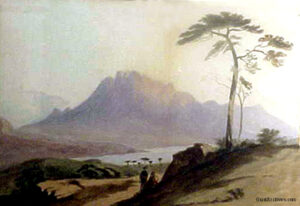 Ulysses liked horses. Father Jesse Grant was foreman of a tannery, which Ulysses didn’t like, so Jesse gave him the job of driving wagonloads of supplies during the years before he left for West Point in 1843, age 17. Ulysses was well-schooled by the time he got to West Point, and he did moderately well there, but enjoyed reading James Fenimore Cooper more than military texts. And, he studied art. He preferred watercolor; nine of his paintings exist today, in museums or private collections. Still, his greatest proficiency was with horses. So wouldn’t you know – when he graduated he didn’t receive a cavalry assignment; he was sent to Fort Barracks near St Louis, the largest military base in the west. The year was 1843, Ulysses was 21 years old. Four years of duty to fulfill my obligation, then resign and become a teacher – that was his plan.
Ulysses liked horses. Father Jesse Grant was foreman of a tannery, which Ulysses didn’t like, so Jesse gave him the job of driving wagonloads of supplies during the years before he left for West Point in 1843, age 17. Ulysses was well-schooled by the time he got to West Point, and he did moderately well there, but enjoyed reading James Fenimore Cooper more than military texts. And, he studied art. He preferred watercolor; nine of his paintings exist today, in museums or private collections. Still, his greatest proficiency was with horses. So wouldn’t you know – when he graduated he didn’t receive a cavalry assignment; he was sent to Fort Barracks near St Louis, the largest military base in the west. The year was 1843, Ulysses was 21 years old. Four years of duty to fulfill my obligation, then resign and become a teacher – that was his plan.
Ulysses met Julia Dent ((1826-1902) while he was in Missouri; her brother Frederick was friends with Ulysses at West Point; he introduced them. Then Ulysses was sent off to fight in a 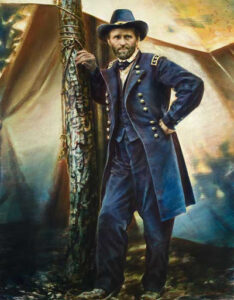 war; something he definitely did NOT want to do. He was 24 when he found himself serving under Generals Zachary Taylor and Winfield Scott in the Mexican War. Here’s the timeline of what happened next:
war; something he definitely did NOT want to do. He was 24 when he found himself serving under Generals Zachary Taylor and Winfield Scott in the Mexican War. Here’s the timeline of what happened next:
- 1848, age 26: Married Julia in Missouri, stationed in Michigan, then New York
- 1850, age 28: Son Frederick born
- 1852, age 30: Stationed in Oregon Territory, son Ulysses born
- 1854, age 32: Stationed in California
By this point, well beyond the time he’d planned to be away from the demands of a military career, drinking got him out. He was at Fort Humboldt in California, a captain, when reprimanded for a drinking episode. He promised to resign if it happened again; it did, and he was finally out of the Army, no court martial, no bad mark against his name. Back to Missouri, reunited with his wife and two sons; and no job. The next seven years were not good.
Ulysses’ father offered him a job in his leather business, but demanded that Julia and the children remain with her family in Missouri. They declined that offer. Ulysses took up farming on his brother-in-law’s Missouri farm; but had to sell firewood on the street corners of St Louis to survive. Daughter Ellen was born that year. They moved to some land on the 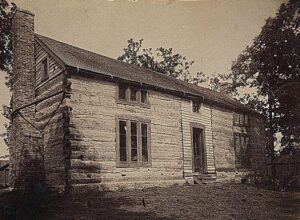 farm of Julia’s father and built a little cabin they named “Hardscrabble.” The Panic of 1857 was devasting to farmers; Ulysses sold his gold watch, rented out Hardscrabble, and moved to the plantation of Julia’s father. Suffering from malaria, he gave up farming, and son Jesse was born.
farm of Julia’s father and built a little cabin they named “Hardscrabble.” The Panic of 1857 was devasting to farmers; Ulysses sold his gold watch, rented out Hardscrabble, and moved to the plantation of Julia’s father. Suffering from malaria, he gave up farming, and son Jesse was born.
In 1859 Ulysses took a position in St Louis with Julia’s cousin, working in the real estates business as a bill collector. No success there either; he then applied for a position as county engineer, but was passed over because he was believed to share his father-in-law’s Democratic sentiments. By this time Ulysses’ father had turned the business of his many leather stores over to his sons, so Ulysses joined his brothers and moved his family to the store in Galena, Illinois. Ulysses did routine work, tended the books, and traveled to neighboring states to purchase green hides from local farmers. A reputable citizen now, he couldn’t vote in the 1860 election because he was not yet a legal resident of Illinois, but he favored Democrat Stephen Douglas over Abraham Lincoln. He was torn – he was strongly anti-slavery; Julia remained a staunch Democrat. Nevertheless, on April 15, 1861, the day after the attack on Fort Sumter, he answered Lincoln’s call for seventy-five thousand volunteers, and re-enlisted in the Army.
Let’s Get Together Again
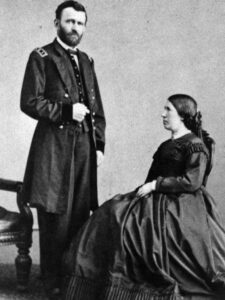 At the beginning of the Civil War, Ulysses helped organize volunteers; then took command of the Illinois troops; was promoted to brigadier general; then major general. But he didn’t do this without Julia. Over the course of the Civil War Julia stayed with Ulysses during campaigns at Memphis, Vicksburg, Nashville, and Virginia. She covered more than 10,000 miles in four years to be with her husband. And she was accompanied by her slave. That’s right — the spouse of the leader of the Union Army fighting to preserve the Union and abolish slavery visited her husband’s encampments often, sometimes traveling alone and sometimes with their children in tow, who were watched over by Jule.
At the beginning of the Civil War, Ulysses helped organize volunteers; then took command of the Illinois troops; was promoted to brigadier general; then major general. But he didn’t do this without Julia. Over the course of the Civil War Julia stayed with Ulysses during campaigns at Memphis, Vicksburg, Nashville, and Virginia. She covered more than 10,000 miles in four years to be with her husband. And she was accompanied by her slave. That’s right — the spouse of the leader of the Union Army fighting to preserve the Union and abolish slavery visited her husband’s encampments often, sometimes traveling alone and sometimes with their children in tow, who were watched over by Jule.
Julia grew up on a plantation with slaves, and “Black Julia” or “Jule,” as she came to be known, was with Julia from an early age. Julia wrote in her memoirs “When I visited the General during the war, I nearly always had Jule with me as a nurse. She came near being captured at Holly Springs.” At one point, Julia lived at Walter Place, an Antebellum mansion in Holly Springs, Mississippi. When Confederate General Earl Van Dorn raided the house, he was not permitted by the pro-Union owner to enter before she went outside, with Jule kept safe.
 Lincoln realized how Julia’s presence affected her husband; he supported her visits. Letters between Julia and Ulysses show she was a trusted confidant; it was Julia’s suggestion that Ulysses invite President Lincoln, first lady Mary, and their son, Tad, to visit him at the front lines. On April 9, 1865, Ulysses S Grant accepted the surrender of Confederate General Robert E Lee at Appomattox Court House in Virginia, effectively ending the Civil War. The Lincolns invited the Grants to a play at the Ford Theater five days later, but they declined. How different history might have been had they gone! Ulysses S Grant was meant to be killed that evening too, but he was home with Julia.
Lincoln realized how Julia’s presence affected her husband; he supported her visits. Letters between Julia and Ulysses show she was a trusted confidant; it was Julia’s suggestion that Ulysses invite President Lincoln, first lady Mary, and their son, Tad, to visit him at the front lines. On April 9, 1865, Ulysses S Grant accepted the surrender of Confederate General Robert E Lee at Appomattox Court House in Virginia, effectively ending the Civil War. The Lincolns invited the Grants to a play at the Ford Theater five days later, but they declined. How different history might have been had they gone! Ulysses S Grant was meant to be killed that evening too, but he was home with Julia.
After the War and Reconstruction
During the years of Johnson’s presidency, the Johnson-Grant relationship went from warm to icy cold; Johnson didn’t attend Ulysses inauguration on March 4, 1869. But Julia did; she was thrilled! She had been a major part of Ulysses’ campaign, though he had been reluctant to run.
After four years of war, Abraham Lincoln’s assassination, and Andrew Johnson’s impeachment trial, Washington was ready for someone like Julia. She gave lavish state dinners, and also received callers at informal receptions, with one stipulation – the women must wear hats, and the men must leave their weapons at home. She was devastated when Ulysses refused to run for a third term. But he was done; for eight years the issues of reconstruction had consumed the country; it wasn’t settled yet. The Compromise of 1877, signed in March, left the end of it squarely in the new president’s hands. (Rutherford B Hayes story next.)
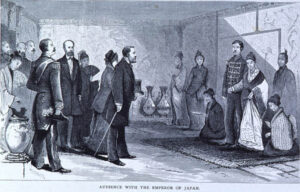 Claiming “I was never so happy in my life!” Ulysses left Washington. By May he and Julia were off to England. They kept going, around the world, stopping in Europe, Africa, India, the Middle East, the Far East, meeting with dignitaries along the way. President Hayes considered them “unofficial diplomats” and provided transportation on US Navy ships – five months in the Mediterranean on the USS Vandalia; travel from Hong Kong to China on the USS Ashuelot; travel from China to Japan on the USS Richmond. They crossed the Pacific on the SS City of Tokio, escorted by a Japanese man-of-war, and landed in San Francisco in September of 1879, greeted by cheering crowds.
Claiming “I was never so happy in my life!” Ulysses left Washington. By May he and Julia were off to England. They kept going, around the world, stopping in Europe, Africa, India, the Middle East, the Far East, meeting with dignitaries along the way. President Hayes considered them “unofficial diplomats” and provided transportation on US Navy ships – five months in the Mediterranean on the USS Vandalia; travel from Hong Kong to China on the USS Ashuelot; travel from China to Japan on the USS Richmond. They crossed the Pacific on the SS City of Tokio, escorted by a Japanese man-of-war, and landed in San Francisco in September of 1879, greeted by cheering crowds.
And the Grants were broke again.
Most of their savings were gone, but a wealthy friend bought them a home on Manhattan’s Upper East Side. Their son Buck (Ulysses Jr) had opened a Wall Street brokerage house there, and – long story short – things turned sour, Ulysses borrowed a huge sum of money to save the venture, but it still went bust. Ulysses sold off war mementos, handed over title to his house, began writing his memoirs, and was diagnosed with throat cancer. Frantic to make sure he left Julia with enough money to live on, he finished his memoirs just days before he died on July 23, 1885, at the age of 63.
 This man was mourned. President Grover Cleveland ordered a thirty-day nationwide period of mourning. After private services, the honor guard placed his body on a special funeral train, which traveled to West Point and New York City; it was viewed by a quarter of a million people. Tens of thousands of men, many of them veterans, marched with the casket drawn by two dozen black stallions. His pallbearers included Union generals Sherman and Sheridan, Confederate generals Simon Bolivar Buckner and Joseph E. Johnston, Admiral David Dixon Porter, and Senator John A. Logan. Following the casket in the seven-mile-long procession were President Cleveland, the two living former presidents Hayes and Arthur, all of the President’s Cabinet, and the justices of the Supreme Court. Attendance at the funeral topped 1.5 million. Ceremonies were held in other major cities around the country, while Grant was eulogized in the press and likened to George Washington and Abraham Lincoln.
This man was mourned. President Grover Cleveland ordered a thirty-day nationwide period of mourning. After private services, the honor guard placed his body on a special funeral train, which traveled to West Point and New York City; it was viewed by a quarter of a million people. Tens of thousands of men, many of them veterans, marched with the casket drawn by two dozen black stallions. His pallbearers included Union generals Sherman and Sheridan, Confederate generals Simon Bolivar Buckner and Joseph E. Johnston, Admiral David Dixon Porter, and Senator John A. Logan. Following the casket in the seven-mile-long procession were President Cleveland, the two living former presidents Hayes and Arthur, all of the President’s Cabinet, and the justices of the Supreme Court. Attendance at the funeral topped 1.5 million. Ceremonies were held in other major cities around the country, while Grant was eulogized in the press and likened to George Washington and Abraham Lincoln.
As for Julia – Mark Twain published The Personal Memoirs of U. S. Grant which focused on Ulysses’ military career; he marketed it to veterans as Ulysses’ death was being mourned. Julia lived another 17 years, and received about $450,000 (equivalent to $12,800,000 today) in royalties.
You really should visit Grant’s Tomb.
